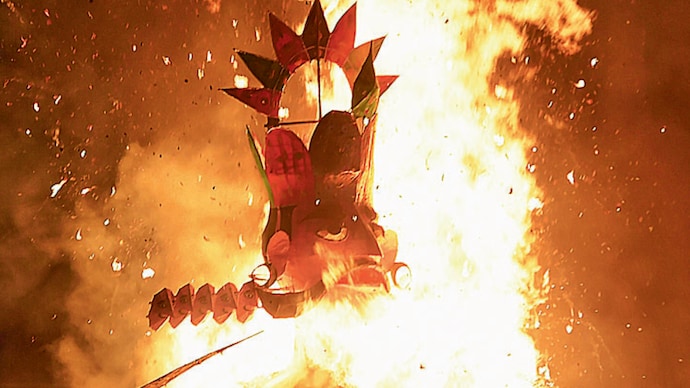Delhi sees spike in air pollution day after burning of Ravana effigies
Air quality monitoring stations in various parts of Delhi showed that air quality worsened in the city after burning of Ravana effigies on Dussehra.

Air quality in Delhi deteriorated soon after after Ravana effigies started burning after sunset on Dussehra day on Tuesday, data recorded by the monitoring stations of Delhi Pollution Control Committee (DPCC) said. At the monitoring station installed at Dwarka, for example, the particulate matter 10 was 96 micrograms per cubic metre of air at 6 pm which increased to 950 micrograms per cubic metre at 10 pm.
"Most of the spike in pollution levels is due to burning of effigies which involves use of crackers," said an official.
Mail Today had on Tuesday carried on its cover a story on how Dussehra may witness polluting fireworks because of stockpiling of old firecrackers for Diwali and flooding of obnoxious Chinese products.
The report said that Hazardous, ear-splitting fireworks, including Chinese ones, were being brought to Delhi from warehouses in neighbouring towns such as Ghaziabad and Meerut. And with no law enforcement around to curb the illegal business, shops sold large quantities of fountains, sparkles, ground spinners, Roman candles, rockets, and Ravan bombs.
In RK Puram, the PM 10 levels was 332 micrograms per cubic metre at 9 pm, which was double the reading recording before sunset. At 6 PM on Wednesday, the PM 10 at the same station was again recorded 332 according to DPCC.
At the monitoring station at Sri Aurobindo Marg, the PM 2.5 levels increased from 23 micrograms per cubic metre at 8 PM on Tuesday to 67 micrograms per cubic metre at 12 midnight. The concentration of nitrogen dioxide was also well above the norms at almost all these stations which the DPCC officials attributed to burning of effigies.
PM 2.5 and PM 10 comprise the major contributing elements to deteriorating air quality due to various factors including fire crackers during winters. Burning of dry leaves, garbage and other biowaste is more common during winters and is a primary cause of local air pollution around this time.
At the station installed at Major Dhyan Chand Stadium PM 2.5 levels increased from 39 micrograms per cubic metre at 8 PM on Tuesday to 91 micrograms per cubic metre at 12 midnight.
However, the overall AQI this Dushera was lowest in last last five years for which CM Arvind Kejriwal thanked Ramlila committees for ensuring that less crackers were used.
Air quality is expected to worsen around Diwali, if the availability of green crackers, as promised by Centre, is not ensured. On the eve of last year's Diwali, the Supreme Court banned conventional firecrackers and ruled that only green ones with reduced emissions will be allowed.
ALSO READ | Delhi set to choke on toxic crackers
ALSO READ | Helping India breathe better
ALSO WATCH | Delhi air pollution spirals out of control
